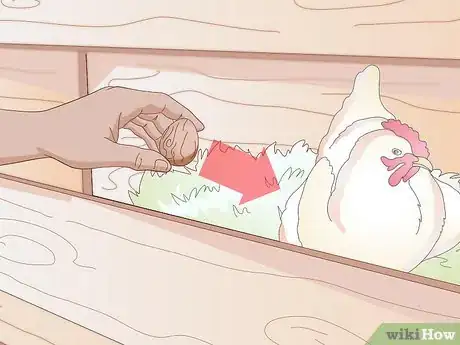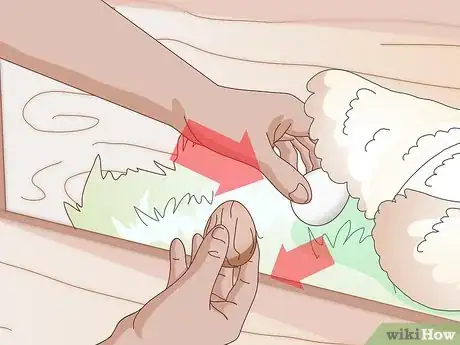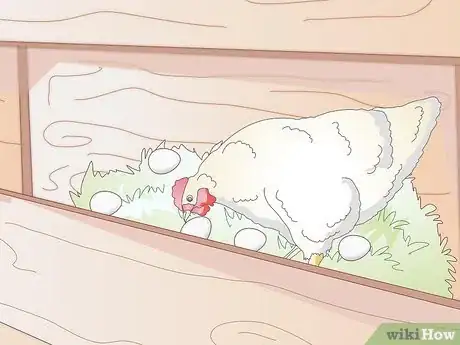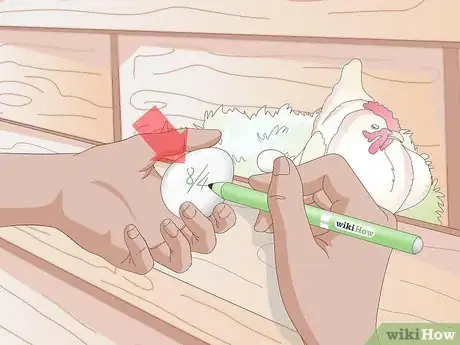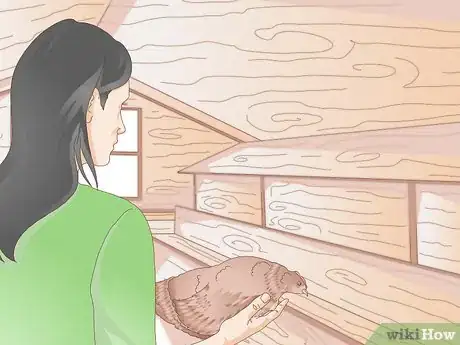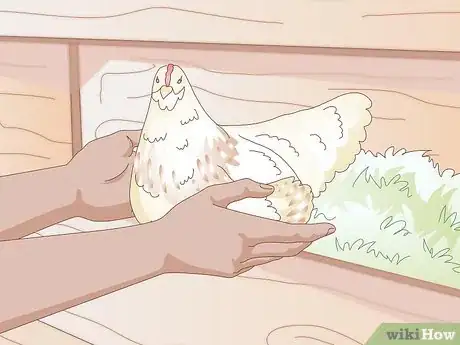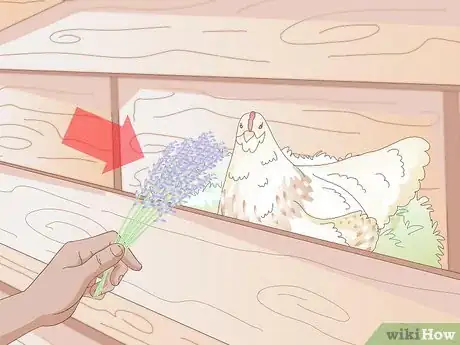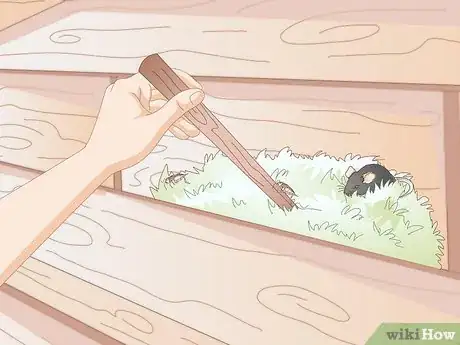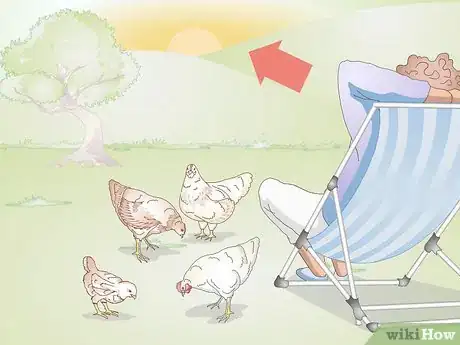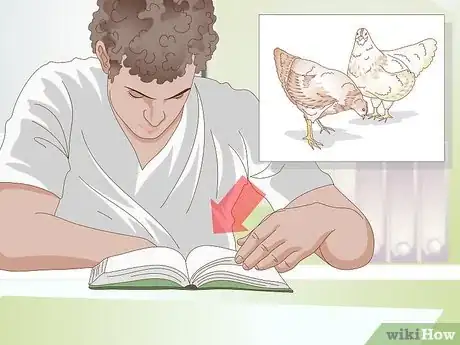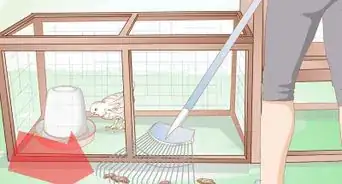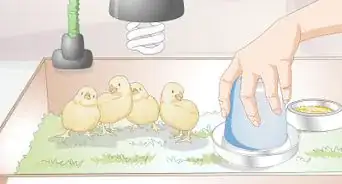This article was co-authored by Pippa Elliott, MRCVS. Dr. Elliott, BVMS, MRCVS is a veterinarian with over 30 years of experience in veterinary surgery and companion animal practice. She graduated from the University of Glasgow in 1987 with a degree in veterinary medicine and surgery. She has worked at the same animal clinic in her hometown for over 20 years.
There are 7 references cited in this article, which can be found at the bottom of the page.
wikiHow marks an article as reader-approved once it receives enough positive feedback. In this case, 88% of readers who voted found the article helpful, earning it our reader-approved status.
This article has been viewed 82,486 times.
If you notice that your hen seems uninterested in sitting on a nest, you might be concerned that she doesn't have the brooding instinct required to hatch her eggs. Fortunately, you can encourage her to go broody with a few simple changes to her environment.
Steps
Stimulating her with Eggs
-
1Place wooden eggs in the nest. One of the most tried-and-true methods to encourage broodiness in your hen is to place dummy eggs in her nest. You may begin by using wooden eggs that can be purchased at most farm stores.[1]
-
2Place golf balls in the nest. Another common approach to using dummy eggs is to place golf balls in the nest. Oddly enough, some hens respond even better to golf balls than they do to manufactured “dummy” eggs.[2]Advertisement
-
3Replace dummy eggs with real eggs. If you have encouraged broody behavior in your hen and she has begun sitting successfully on dummy eggs (wooden eggs, golf balls, or any other dummy eggs) you can swap these dummies for real eggs. This is most easily done at night when the hen is docile and less likely to reject the eggs.[3]
- Always wash your hands thoroughly before handling eggs.
- Some people prefer to swap eggs during the day, so that if an egg gets rejected they can quickly transfer it to an incubator. However, the evening method is still the most common.
-
4Allow her to gather a clutch of eggs. A different, though extremely common, method is simply to allow your hen to gather a clutch of eggs in her nest, that is, to lay numerous eggs without being disturbed. Once your hen has accumulated a few eggs (usually three to five) her broody instinct should kick in.[4]
-
5Consider dating your eggs. If you are giving your hen the space and time to gather a clutch of eggs, you may consider sneaking into her nest and using a magic marker to write the date on her eggs. This way, you can remove eggs that have been in the nest for too long.[5]
Altering her Environment
-
1Move your hen to a quieter location. Creating some subtle changes in your hen’s environment is another effective way to encourage broodiness. Try moving your hen into a calmer, quieter nesting house. This may bring out her broodiness.[6]
-
2Provide a dark place. Another subtle change is to make your hen’s location a bit darker. (You can do this, for example, by hanging fabric over the front of her nesting box.) The darkness encourages her to be calm, and may help her instincts to arise.[7]
-
3Confine her. Many people advocate for the confinement of your hen to her quiet, dark nesting area. It may take some time alone in a calm, comfortable place to stir up a hen’s brooding instinct. Consider giving this method a try.[8]
-
4Add some fresh herbs to her nesting box. If you have access to fresh herbs, the addition of some fresh herbs to your hen’s nesting box may encourage her become calm and broody. Lavender and chamomile are particularly effective.[9]
-
5Check nesting boxes for insects and mice. Your hen may avoid becoming broody (or even laying eggs) if she does not feel clean and safe in her nesting box. Check to be sure that her box is free from mites, insects, mice, and other intruders in order to ensure her comfort and safety.[10]
Providing the Right Circumstances
-
1Wait for the right season. Hens generally become broody during the spring or summer (the warmer months). If you wait for the right season, your hen’s natural instincts and broodiness should kick in on their own. Approach this endeavor with positivity and patience, and wait until the time is right.[11]
-
2Make sure your hen is a broody breed. Modern day breeds (especially show birds) have had their broody instinct bred out by breeders who tend to use incubators. Because of this, it is important to start with a broody breed of hen, such as cochin, buff orpington, light brahmas, or dark Cornish hens.[12]
-
3Integrate a rooster. You will need a rooster in the mix if you want to end up with fertilized eggs and broody hens. The presence of a rooster near your hen is likely to encourage broody behavior.[13]
-
4Acquire a perfect chicken ratio. One rooster to every five hens is the ideal ratio for your chickens. If you are able to maintain this ratio of roosters to hens, you are more likely to get fertilized eggs and to encourage broodiness in your hens.[14]
-
5Set up a nesting box. Your hen needs somewhere safe and comfortable to both lay and sit on the eggs. Create a dry, clean, relatively dark place where your hen can have some privacy. You can purchase these, or construct them yourself out of wood.[15]
- You will need one box for every two to four hens.
- Twelve cubic inches (12" x 12" x 12") is a good size for each box.
- Add some sawdust and/or straw to serve as bedding for your chicken(s).
References
- ↑ http://www.motherearthnews.com/homesteading-and-livestock/encourage-hens-to-hatch-eggs.aspx
- ↑ http://www.motherearthnews.com/homesteading-and-livestock/encourage-hens-to-hatch-eggs.aspx
- ↑ http://www.allaboutchickens.info/broody-hens-guide/
- ↑ http://www.motherearthnews.com/homesteading-and-livestock/encourage-hens-to-hatch-eggs.aspx
- ↑ http://www.motherearthnews.com/homesteading-and-livestock/encourage-hens-to-hatch-eggs.aspx
- ↑ http://www.motherearthnews.com/homesteading-and-livestock/encourage-hens-to-hatch-eggs.aspx
- ↑ http://www.motherearthnews.com/homesteading-and-livestock/encourage-hens-to-hatch-eggs.aspx
- ↑ http://www.motherearthnews.com/homesteading-and-livestock/encourage-hens-to-hatch-eggs.aspx
- ↑ http://www.fresheggsdaily.com/2014/04/five-ways-to-encourage-hen-to-go-broody.html
- ↑ http://www.fresheggsdaily.com/2014/04/five-ways-to-encourage-hen-to-go-broody.html
- ↑ http://hencam.com/faq/the-broody-hen/
- ↑ http://www.motherearthnews.com/homesteading-and-livestock/encourage-hens-to-hatch-eggs.aspx
- ↑ http://hencam.com/faq/the-broody-hen/
- ↑ http://hencam.com/faq/the-broody-hen/
- ↑ http://www.backyardchickens.com/a/pictures-of-chicken-nesting-boxes-how-to-build-a-nest-box
About This Article
To get your hen to become broody, set up a nesting box in a clean, dry, and relatively dark place so your hen can have some privacy. The nesting box should be 12 cubic inches and lined with sawdust or straw for bedding. After you have prepared the nesting box, place wooden eggs in the nest to encourage broodiness. You can purchase wooden eggs at most farm stores. Once your hen begins sitting on the wooden eggs, you should swap them out for real eggs. The best time to do this is at night, since your hen will be docile and less likely to reject them. Alternatively, you can swap the eggs during the day and quickly transfer them to an incubator if they’re rejected. For more advice from our Veterinary co-author, including how to create the best environment for your hen, keep reading!
